- The amusement area, known as the Pay Streak, was a very popular attraction for visitors to the fair. It was here that many Indigenous people were represented in stereotypical ways for public entertainment.
- Although wages were paid to most performers on the Pay Streak, few extracted any long-term benefit from participation in the events. In the bigger picture, Native communities throughout the Pacific were devastated in the wake of commercial exploitation that followed this and other fairs.
- The Indigenous people of Washington State did not traditionally carve totem poles. What many visitors view as symbols of Seattle are, in fact, from much farther north, and represent the clans and families of the indigenous people of Coastal Alaska and Canada.
- In 1909, most westerners lumped the Middle East and India together with China as the "Orient," and all American Indians were stereotyped as Plains warriors in feathered bonnets. The sensational displays of belly dancers, the "death dance of Cleopatra," and the massacre of white settlers at the hands of Indians are but a few examples of how history was distorted or exploited for entertainment at the A-Y-P Exposition and other fairs.
- Of the 1,927 objects collected by George Emmons and purchased for the Burke Museum's collection, 168 were removed from graves. The Burke has been working actively for almost 20 years with Northwest Coast and other Native American communities to return claims under NAGPRA, and does not exhibit grave materials or objects under NAGPRA review without community approval.
|

"Eskimos" with dogsleds, Eskimo exhibit, Pay Streak, Alaska Yukon Pacific Exposition, Seattle, 1909
Photographer unknown, courtesy Special Collections Division, University of Washington Libraries

Billiken
Artist unknown, early 20th century Iñupiaq
|

